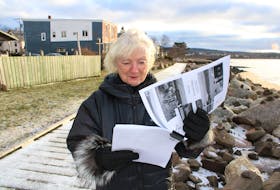
The list of death reports provided through freedom of information includes deaths at six homes at locations around the province, with some having multiple incidents.
Documents obtained through the freedom of information law are substantially redacted and offer only scant details about the incidents, such as a witness calling out “Hey, hey, hey” before observing a 71-year-old man fatally push an 81-year-old last September at Parkstone Enhanced Care residence in Halifax.
Another report from May 2009 at Glen Haven home in New Glasgow says, “medical records...describe an altercation at the home during which the deceased was pushed.”
For licensed practical nurse Rhonda Church, who has worked in the province's nursing homes for 35 years, the previous lack of disclosure of five of eight cases is a problem.
“We need the public to know exactly why and how these things are happening in our long-term health care facilities,” said Church in an interview during a Nova Scotia Nurse's Union meeting last week.
She says the public should also be told what staffing levels were, what exactly the resident mix was on the unit, and what information staff were receiving to help prevent escalation of aggression caused by dementia or mental illnesses.
Janet Hazelton, the president of the Nova Scotia Nurse's Union, argues that without public disclosure - similar to the annual reports prepared for Ontario's chief coroner - citizens don't know the extent of a problem.
“I think people need to understand there are risks. Some of those cases, when it's resident-to-resident (violence) it's often because of a lack of staff,” she said.
Dr. Matthew Bowes, the province's chief medical examiner, says when death is determined to be the “result of violence” under the Fatalities Inquiries Act it is referred to police as a potential homicide and it is up to police to announce details.
The list of deaths includes two incidents at Mountain Lea Lodge in the Annapolis Valley in March 2012 and August 2008; one at Glen Haven Manor in New Glasgow in May 2009; one at the Harbour View Haven in Lunenburg in July 2011; one at the Harbourstone Enhanced Care in Sydney last September; one in Arborstone Nursing Home in Halifax in October 2011; and two at the Parkstone Enhanced Care in Halifax.
Halifax police news releases informed the public of the two cases at Parkstone, where sudden pushes led to deaths in 2013 and last September, and a death at Arborstone, where a resident fell backwards after being pushed.
In the other five cases, the relevant police forces say they decided not to proceed with investigations, meaning no release was issued and the stories never surfaced.
Bowes says it is likely the aggressors are people with dementia-related aggression, but adds he cannot be certain because his governing legislation doesn't allow him to release the medical condition of the people who cause the death.
Asked if a public inquiry should be recommended in any of these deaths, similar to well publicized inquests undertaken by the Ontario and Manitoba coroners' offices, the medical examiner said it doesn't appear to be necessary in Nova Scotia.
“If a public system is reasonably diligent, I don't think hard about a judicial inquiry. I only think hard about it if they (government) are completely ignorant or in denial about an issue,” he said.
“Our health care system does have an awareness of falls of the elderly as an issue, whether accidental or homicidal I suppose.”
Bob Lafferty, director of monitoring and evaluation in the Health Department, said his department doesn't publicly release deaths because there doesn't appear to be an intent to kill.
“Often times these cases may not be violent. They (residents) push them (other residents) out of way and ... it may not be a level of violence,” he said.
His agency carries out an internal inquiry under the Protection of Person in Care Act, however when provided through a freedom of information request most details are removed.
Short summaries in the reports obtained through freedom of information say underlying problems at the facilities played a role in the deaths, such as a lack of details in care plans and a failure to make use of the challenging behaviour expert the province has made available.
Hazelton argues the lack of public discussion adds to a lack of momentum for reforms that other provinces are already exploring or funding.
She says the province and nursing homes should move more quickly on recommendations such as those put forward by the Community Governed Organizations task force last fall, a group that included nurses, representatives from the province, the Alzheimer Society, and nursing homes.
It called for additional training to the front-line staff on ways to identify aggression and de-escalate outbursts, and comments that access to the training is “not equitable due to limited resources.”
Meanwhile, high-profile public inquests and recommendations from a committee formed by the Ontario chief coroner has helped fuel some steps, says Candace Chartier, chief executive of the Ontario Long Term Care Association.
She said she's pleased the Liberal government's last budget will provide $10 million a year for three years for programs that can help reduce aggression and other behavioural problems.
“I favour a system of transparency. The more we know about what's happening in long term care, the more we can learn about why it happened,” she said.
“It puts more eyes on the issues.”
What the records say about deaths in Nova Scotia's long-term care facilities
THE CANADIAN PRESS
Eight seniors have died in long-term care homes in Nova Scotia from 2008 to 2016 as “a result of violence,” as described in death reports to the government. As noted, the public was previously told about three incidents. This is a list of the descriptions of the incidents, taken from government records:
Aug. 12, 2008, Mountain Lea Lodge, Bridgetown
Circumstances: “(Blank) had dementia and was placed at (blank). After only being there for (blank) was pushed by another resident, fell and (blank).”
What authorities told the public: RCMP did not issue a public notice because “case not deemed to be criminal in nature.”
May 18, 2009, Glen Haven Manor, New Glasgow
Circumstances: “She (a staff person) is reporting the death ... a short time ago in their facility. Medical records history describes an 'altercation' at the nursting home during which decedent was pushed by another resident where (blank) fell on (blank).”
What authorities told the public: New Glasgow police did not issue a public notice due to decision not to proceed with criminal investigation.
July 8, 2011, Harbour View Haven, Lunenburg
Circumstances: These are severely redacted. The statement says only, “Deceased fell on (blank) at the nursing home and prior to the fall decedent was able to (blank).”
What authorities told the public: RCMP did not issue a public notice because “case not deemed to be criminal in nature.”
Feb. 5, 2011, Arborstone, Halifax
Circumstances: “The deceased was in a hallway and there was an altercation between the deceased and another resident. The deceased was apparently 'shoved to the floor with great force,' striking a wall and later noted to have a possible (blank).”
What authorities told the public: Halifax police announced an investigation and then announced there would be no charges following a homicide investigation into the death of 92-year-old woman who was hurt in the fall. Police said the woman died from injuries related to the fall about a month after she was pushed by another resident in a dementia unit on Jan. 7. At the time, The Canadian Press reported that the Arborstone Enhanced Care Nursing Home issued a statement saying neither woman had a history of aggressive behaviour towards each other or other clients.
March 1, 2012, Mountain Lea Lodge, Bridgetown
Circumstances: “In its investigation, one of the residents told the staff that the deceased had been pushed by (blank) ... ”
What authorities told the public: RCMP did not issue a public notice because “case not deemed to be criminal in nature.”
Oct. 6, 2013, Parkstone Enhanced Care, Halifax
Circumstances: “A resident ... was pushed by another resident causing (blank) to fall backwards.”
What authorities told the public: Halifax police announced an investigation. Following a news release, CTV news reported that a 74-year-old woman allegedly got into an altercation with a 91-year-old woman.
Sept. 15, 2015, Harbourstone Enhanced Care, Sydney
Circumstances: “According to the notes, the deceased was pushed by another resident ... at a nursing home.”
What authorities told the public: Police did not publicize the case after deciding there was no criminal intent.
Sept. 20, 2015, Parkstone Enhanced Care, Halifax
Circumstances: “Another patient pushed the deceased causing ... to fall to the floor striking (blank).”
What authorities told the public: Halifax police announced a homicide investigation and later announced the case was dropped. They said a 71-year-old man was involved in an altercation with an 81-year-old man at the facility and was not charged because he had a cognitive impairment.
(SOURCE: Nova Scotia Medical Examiner Service, Halifax police, RCMP, New Glasgow police, CBRM police. Dates provided are for reports on the deaths, not actual incidents.)








